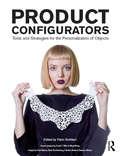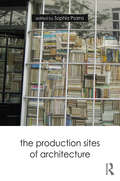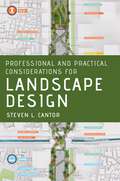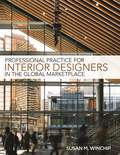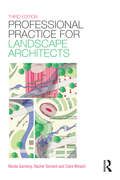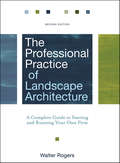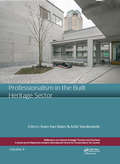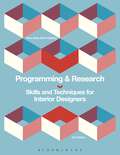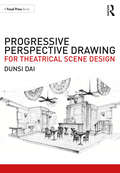- Table View
- List View
Product Configurators: Tools and Strategies for the Personalization of Objects
by Fabio SchillaciThis book provides a source of inspiration and a manual for designers, entrepreneurs and professionals who are looking into the practical application of product configurators. In this growing profession, there is a need for a book which focuses on the configuration process from a design perspective. The book delves into the practical application of configurators using case studies of selected firms that present their most significant works. It offers the reader tips, suggestions, technical details and critical issues which need to be considered, from experienced actors and pioneers worldwide, which include: Unfold, Belgium In-flexions, France Nervous System, USA Okinlab, Germany SkimLab, France Twikit, Belgium INDG, The Netherlands ZeroLight, United Kingdom 3Dimerce, The Netherlands 3DSource, USA Bagaar, Belgium MyCustomizer, Canada Combeenation, Austria
The Production Sites of Architecture
by Sophia PsarraThe Production Sites of Architecture examines the intimate link between material sites and meaning. It explores questions such as: how do spatial configurations produce meaning? What are alternative modes of knowledge production? How do these change our understanding of architectural knowledge? Featuring essays from an international range of scholars, the book accepts that everything about the production of architecture has social significance. It focuses on two areas: firstly, relationships of spatial configuration, form, order and classification; secondly, the interaction of architecture and these notions with other areas of knowledge, such as literature, inscriptions, interpretations, and theories of classification, ordering and invention. Moving beyond perspectives which divide architecture into either an aesthetic or practical art, the authors show how buildings are informed by intersections between site and content, space and idea, thought and materiality, architecture and imagination. Presenting illustrated case studies of works by architects and artists including Amale Andraos, Dan Wood, OMA, Koen Deprez and John Soane, The Production Sites of Architecture makes a major contribution to our understanding of architectural theory.
The Production Sites of Architecture
by Sophia PsarraThe Production Sites of Architecture examines the intimate link between material sites and meaning. It explores questions such as: how do spatial configurations produce meaning? What are alternative modes of knowledge production? How do these change our understanding of architectural knowledge? Featuring essays from an international range of scholars, the book accepts that everything about the production of architecture has social significance. It focuses on two areas: firstly, relationships of spatial configuration, form, order and classification; secondly, the interaction of architecture and these notions with other areas of knowledge, such as literature, inscriptions, interpretations, and theories of classification, ordering and invention. Moving beyond perspectives which divide architecture into either an aesthetic or practical art, the authors show how buildings are informed by intersections between site and content, space and idea, thought and materiality, architecture and imagination. Presenting illustrated case studies of works by architects and artists including Amale Andraos, Dan Wood, OMA, Koen Deprez and John Soane, The Production Sites of Architecture makes a major contribution to our understanding of architectural theory.
Productivity of Cities (Routledge Revivals)
by Sung- Jong KimFirst published in 1997, this volume from the Bruton Center for Development Studies examines urban productivity and the Korean urban system. The Center recognizes the growing significance of information and technology in local, national and global development. Research conducted within the Center includes both theoretical and empirical investigations of regional housing markets; mobility and location choices of households and businesses; interaction of land use and transportation; relationships between spatial patterns of development and the dynamics of regional economies, and on the interaction of market forces and public policies in shaping development.
Productivity of Cities (Routledge Revivals)
by Sung- Jong KimFirst published in 1997, this volume from the Bruton Center for Development Studies examines urban productivity and the Korean urban system. The Center recognizes the growing significance of information and technology in local, national and global development. Research conducted within the Center includes both theoretical and empirical investigations of regional housing markets; mobility and location choices of households and businesses; interaction of land use and transportation; relationships between spatial patterns of development and the dynamics of regional economies, and on the interaction of market forces and public policies in shaping development.
Professional and Practical Considerations for Landscape Design
by Steven L. CantorDrawing on decades of professional practice and teaching experience, Steven L. Cantor's Professional and Practical Considerations for Landscape Design explains the field of landscape architecture, outlining with authority how to turn drawings of designs into creative, purposeful, and striking landscapes and landforms in today's world. This comprehensive guide consists of everything a young professional might encounter from conception through final project archiving, ensuring readers have both the tools necessary to keep up with advancements in the field and the practical business knowledge to build life-long partnerships. Each of the book's concise chapters emphasize a specific aspect of landscape architecture practice, from the administration of designs for contracts, areas of practice, human resources, marketing, construction materials, sustainability and ethics. Each chapter is written in a style that best suits the material. Alongside detailed definitions and practical "do's and don'ts" are 30 complex sample problems ranging in difficulty for both individuals and groups. An array of original photographs and clear examples in both black and white and color articulate standards and inspire future possibilities, featuring the work of Vicky Chan, founder of Avoid Obvious Architects, and Richard Alomar, Associate Professor of Landscape Architecture at Rutgers and co-founder of New York Urban Sketchers. By combining the author's unique depth of knowledge with real-world case studies from America, Asia, and Europe, Professional and Practical Considerations for Landscape Design is an up-to-date resource for every level of reader, from students in landscape architecture programs to professionals working in public or private practice, engineering, consulting, or contracting.
Professional and Practical Considerations for Landscape Design
by Steven L. CantorDrawing on decades of professional practice and teaching experience, Steven L. Cantor's Professional and Practical Considerations for Landscape Design explains the field of landscape architecture, outlining with authority how to turn drawings of designs into creative, purposeful, and striking landscapes and landforms in today's world. This comprehensive guide consists of everything a young professional might encounter from conception through final project archiving, ensuring readers have both the tools necessary to keep up with advancements in the field and the practical business knowledge to build life-long partnerships. Each of the book's concise chapters emphasize a specific aspect of landscape architecture practice, from the administration of designs for contracts, areas of practice, human resources, marketing, construction materials, sustainability and ethics. Each chapter is written in a style that best suits the material. Alongside detailed definitions and practical "do's and don'ts" are 30 complex sample problems ranging in difficulty for both individuals and groups. An array of original photographs and clear examples in both black and white and color articulate standards and inspire future possibilities, featuring the work of Vicky Chan, founder of Avoid Obvious Architects, and Richard Alomar, Associate Professor of Landscape Architecture at Rutgers and co-founder of New York Urban Sketchers. By combining the author's unique depth of knowledge with real-world case studies from America, Asia, and Europe, Professional and Practical Considerations for Landscape Design is an up-to-date resource for every level of reader, from students in landscape architecture programs to professionals working in public or private practice, engineering, consulting, or contracting.
Professional Practice for Interior Designers
by Christine M. PiotrowskiThis updated edition of the most comprehensive business guide for designers covers the interior design profession in a clear and well-organized style. From establishing a practice to managing a project, the reader progresses through all aspects of the business, whether in a small or large firm. The new edition includes additional information on ethics, as well as a companion website containing sample forms and other resources. This book is recommended by the NCIDQ as preparation for their professional registration examination.
Professional Practice for Interior Designers
by Christine M. PiotrowskiThis updated edition of the most comprehensive business guide for designers covers the interior design profession in a clear and well-organized style. From establishing a practice to managing a project, the reader progresses through all aspects of the business, whether in a small or large firm. The new edition includes additional information on ethics, as well as a companion website containing sample forms and other resources. This book is recommended by the NCIDQ as preparation for their professional registration examination.
Professional Practice for Interior Designers
by Christine M. PiotrowskiThe leading guide to the business practice of the interior design profession, updated to reflect the latest trends For nearly thirty years, Professional Practice for Interior Designers has been a must-have resource for aspiring designers and practicing professionals. This revised and updated Sixth Edition continues to offer authoritative guidance related to the business of the interior design profession—from the basics to the latest topics and tools essential for planning, building, and maintaining a successful commercial or residential interior design business. Filled with business tips and best practices, illustrative scenarios, and other pedagogical tools, this revised edition contains new chapters on interior design in the global environment, building client relationships, and online marketing communications. The author also includes updated information on web and social media marketing, branding, and prospecting for global projects. Recommended by the NCIDQ for exam preparation, this Sixth Edition is an invaluable resource for early career designers or those studying to enter the profession. This important book: Contains three new chapters that focus on client relationships, marketing communications, and interior design in the global marketplace. Includes new or updated sections that reflect the recent trends related to social media, branding, sustainable design practice and more Offers invaluable pedagogical tools in every chapter, including chapter objectives and material relevant for the NCIDQ Instructors have access to an Instructor's Manual through the book's companion website
Professional Practice for Interior Designers
by Christine M. PiotrowskiThe leading guide to the business practice of the interior design profession, updated to reflect the latest trends For nearly thirty years, Professional Practice for Interior Designers has been a must-have resource for aspiring designers and practicing professionals. This revised and updated Sixth Edition continues to offer authoritative guidance related to the business of the interior design profession—from the basics to the latest topics and tools essential for planning, building, and maintaining a successful commercial or residential interior design business. Filled with business tips and best practices, illustrative scenarios, and other pedagogical tools, this revised edition contains new chapters on interior design in the global environment, building client relationships, and online marketing communications. The author also includes updated information on web and social media marketing, branding, and prospecting for global projects. Recommended by the NCIDQ for exam preparation, this Sixth Edition is an invaluable resource for early career designers or those studying to enter the profession. This important book: Contains three new chapters that focus on client relationships, marketing communications, and interior design in the global marketplace. Includes new or updated sections that reflect the recent trends related to social media, branding, sustainable design practice and more Offers invaluable pedagogical tools in every chapter, including chapter objectives and material relevant for the NCIDQ Instructors have access to an Instructor's Manual through the book's companion website
Professional Practice for Interior Designers in the Global Marketplace
by Susan WinchipThe interior designers of tomorrow require a professional practice text that is contemporary and innovative enough to prepare them for the rapidly evolving landscape of the 21st century workplace. Professional Practice for Interior Designers in the Global Marketplace arms students of the Millennial Generation with the know-how they'll need to launch and evolve their careers. It emphasizes the essential skills and knowledge required to work in a firm as an entry-level designer, while providing an overview of what is involved in starting, owning, and operating an interior design business. Although rooted in fundamentals, the book incorporates up-to-the-minute developments including globalization, changing demographics, the rise of networking technologies, sustainable design, social responsibility, and global economics.
Professional Practice for Landscape Architects
by Rachel Tennant Nicola Garmory Clare WinschProfessional Practice for Landscape Architects third edition deals with the practical issues of being a successful landscape architect professional. Endorsed by the Landscape Institute, this book is an indispensable guide for licentiate members of the Institute on their Pathway to Chartership. It follows the revised 2013 syllabus covering all aspects of professional judgement, ethics and values, the legal system, organisation and management, legislation and the planning system, environmental policy and control, procurement and implementation. It also serves as a reminder and reference for fully qualified professionals in their everyday practice and for landscape students. Valuable information is presented in an easy to follow manner with diagrams and schedules, key acts, professional documents and contracts clearly explained and made easy to understand. A handy list of questions are included to aid with P2C revision, answers of which are found within the text.
Professional Practice for Landscape Architects
by Rachel Tennant Nicola Garmory Clare WinschProfessional Practice for Landscape Architects third edition deals with the practical issues of being a successful landscape architect professional. Endorsed by the Landscape Institute, this book is an indispensable guide for licentiate members of the Institute on their Pathway to Chartership. It follows the revised 2013 syllabus covering all aspects of professional judgement, ethics and values, the legal system, organisation and management, legislation and the planning system, environmental policy and control, procurement and implementation. It also serves as a reminder and reference for fully qualified professionals in their everyday practice and for landscape students. Valuable information is presented in an easy to follow manner with diagrams and schedules, key acts, professional documents and contracts clearly explained and made easy to understand. A handy list of questions are included to aid with P2C revision, answers of which are found within the text.
The Professional Practice of Landscape Architecture: A Complete Guide to Starting and Running Your Own Firm (Coursesmart Ser.)
by Walter RogersThe all-inclusive reference to starting and operating a landscape architecture firm The Professional Practice of Landscape Architecture, Second Edition is completely revised to keep up with the latest developments driving the day-to-day operation of a successful private-practice landscape architecture office. Whether helping a landscape architecture student identify a career track, providing direction on starting a new office, guiding an owner seeking to jumpstart a stagnant or fledgling business, or assisting a landscape architect-in-training study for the national Landscape Architecture Registration Exam (LARE), this single-source blueprint is the key to prospering in this dynamic field. This new edition features: Indispensible information for practicing landscape architects, including professional ethics, finances, office administration, marketing and promotion, and project management An updated look at government regulatory laws, federal tax administration, sustainable design, and LEED certification Strategies for using the Internet, computer software, and technology to market and manage a firm Examples of professional contract templates Case study profiles of landscape architecture firms Requirements for professional registration and criteria for taking the national exam This comprehensive and practical reference combines real-world experience with the highest professional standards to instruct the reader on business concepts. Expertly organized and easy to follow, The Professional Practice of Landscape Architecture, Second Edition continues to be the one source that landscape architects need to direct all facets of their practice.
The Professional Practice of Landscape Architecture: A Complete Guide to Starting and Running Your Own Firm
by Walter RogersThe all-inclusive reference to starting and operating a landscape architecture firm The Professional Practice of Landscape Architecture, Second Edition is completely revised to keep up with the latest developments driving the day-to-day operation of a successful private-practice landscape architecture office. Whether helping a landscape architecture student identify a career track, providing direction on starting a new office, guiding an owner seeking to jumpstart a stagnant or fledgling business, or assisting a landscape architect-in-training study for the national Landscape Architecture Registration Exam (LARE), this single-source blueprint is the key to prospering in this dynamic field. This new edition features: Indispensible information for practicing landscape architects, including professional ethics, finances, office administration, marketing and promotion, and project management An updated look at government regulatory laws, federal tax administration, sustainable design, and LEED certification Strategies for using the Internet, computer software, and technology to market and manage a firm Examples of professional contract templates Case study profiles of landscape architecture firms Requirements for professional registration and criteria for taking the national exam This comprehensive and practical reference combines real-world experience with the highest professional standards to instruct the reader on business concepts. Expertly organized and easy to follow, The Professional Practice of Landscape Architecture, Second Edition continues to be the one source that landscape architects need to direct all facets of their practice.
Professionalism in the Built Heritage Sector: Edited Contributions to the International Conference on Professionalism in the Built Heritage Sector, February 5-8, 2018, Arenberg Castle, Leuven, Belgium
by Koen Van Balen Aziliz VandesandeProfessionalism entails the conduct, aims and qualities that characterise a profession. The term is also used to describe education and training standards for the knowledge and skills necessary to perform a specific profession. In practice, professional standards of practice and ethics are agreed upon and maintained by recognised associations. In the past, professionalism has not occupied a central place in built heritage discussions, policy and research. Recent changes in terms of public attitudes and sustainability concerns have had a cumulative impact on the requirements for professionalism in the built heritage sector. The future success of the sector will depend on the availability of adequate professionals and an appropriately skilled workforce. In practice, the built heritage sector involves much more than interventions to conserve, preserve, rehabilitate or restore a heritage structure. Bringing a project to fruition begins with the formulation of a policy, proceeds to the design and execution of intervention strategies and ends with ongoing maintenance of heritage structures and related future programming. This process requires sufficient interactions between different professionals to obtain a common vision and hold that vision throughout a project. At the same time, the sustainability of the sector is also defined by effective governance, societal support and cultural rationales. Professionalism in the Built Heritage Sector contains reports on the lectures of the international conference organized by the Raymond Lemaire International Centre for Conservation (Leuven, Belgium, February 5th-8th, 2018). The contributions in this volume meet the increasing demand for shared information to support the transition towards a more sustainable conservation process. The volume consists of three main parts that deal with practice-led research or scientific research: "Profiles and capacities", "Education, training and quality labels", and "Obstacles and changes".
Programming and Research: Skills and Techniques for Interior Designers
by Rose Mary Botti-SalitskyProgramming and Research: Skills and Techniques for Interior Designers, Second Edition, provides a step-by-step approach to mastering the process of documenting client and user requirements for any design project. Replete with examples and analyses of student and professional work, this book guides its readers through the creation of their own program documents. Both the National Council for Interior Design Qualification (NCIDQ) and the Council for Interior Design Accreditation (CIDA) consider programming a required core of knowledge. Programming and Research focuses on how the study of programming for interior designers prepares students for and advances them into the professional realm.Features-More than 100 images, including student work, help illustrate and explain the programming process -Appendices include actual programming documents used by successful interior design firms, a residential questionnaire, and a list of helpful resources -Key terms are highlighted in the text and defined in a comprehensive glossary New to this Edition-Updated with new coverage on evidence-based design, integrated project delivery (IPD), building information modeling (BIM), design across disciplines, LEED programming, designing on a budget, and time management -New examples and case studies throughout cover new technological tools being employed in the industry to collect data -More intuitive integration of art and graphics to explanations in the text Teaching Resources-Instructor's Guide provides suggestions for planning the course and using the text in the classroom, supplemental assignments, lecture notes, and sample test questions -PowerPoint® presentations include images from the book and provide a framework for lecture and discussion
Programming for Health and Wellbeing in Architecture
by Keely Menezes A. Vernon Woodworth Pamela De Oliveira-SmithProgramming for Health and Wellbeing in Architecture presents a new approach to architectural programming that includes sustainability, neuroscience and human factors. This volume of contributions from noted architects and academics makes the case for rethinking the practices of programming and planning to incorporate evidence-based design, systems thinking and a deeper understanding of our evolutionary nature. These 18 original essays highlight how human and environmental health are closely related and should be incorporated as mutually reinforcing goals in every design project. Together, these chapters describe the framework for a new paradigm of building performance and design of the human experience. Programming—the stage at which research is conducted and goals established—provides an opportunity to examine potential impacts and to craft strategies for wellbeing in new buildings and renovations using the latest scientific methods. This book expands the scope of the programming process and provides essential guidance for sustainable practice and the advancement of wellbeing in the built environment for architecture and interiors students, practitioners, instructors and academics.
Programming for Health and Wellbeing in Architecture
by Keely Menezes MphProgramming for Health and Wellbeing in Architecture presents a new approach to architectural programming that includes sustainability, neuroscience and human factors. This volume of contributions from noted architects and academics makes the case for rethinking the practices of programming and planning to incorporate evidence-based design, systems thinking and a deeper understanding of our evolutionary nature. These 18 original essays highlight how human and environmental health are closely related and should be incorporated as mutually reinforcing goals in every design project. Together, these chapters describe the framework for a new paradigm of building performance and design of the human experience. Programming—the stage at which research is conducted and goals established—provides an opportunity to examine potential impacts and to craft strategies for wellbeing in new buildings and renovations using the latest scientific methods. This book expands the scope of the programming process and provides essential guidance for sustainable practice and the advancement of wellbeing in the built environment for architecture and interiors students, practitioners, instructors and academics.
Programming Interior Environments: A Practical Guide for Students
by Cynthia M. KarpanProgramming Interior Environments introduces a four-component framework you can use to program interiors, and twelve methods for you to gather, analyze and synthesize programmatic information to take the guesswork out of your studio projects. This book studies the Student Programming Model: a realistic programming process for college and university interior design students that allows students to create accurate and in-depth programming documents essential for informing the design process. This is done whilst keeping in mind that students are often working solo, with imaginary clients and end users in mind, and collecting program information within strict time constraints. Including three appendices of student programs created following these guidelines, to help you understand how to apply the framework components and inquiry methods in your own work, this book is ideal for students and professionals in interior design and interior architecture.
Programming Interior Environments: A Practical Guide for Students
by Cynthia M. KarpanProgramming Interior Environments introduces a four-component framework you can use to program interiors, and twelve methods for you to gather, analyze and synthesize programmatic information to take the guesswork out of your studio projects. This book studies the Student Programming Model: a realistic programming process for college and university interior design students that allows students to create accurate and in-depth programming documents essential for informing the design process. This is done whilst keeping in mind that students are often working solo, with imaginary clients and end users in mind, and collecting program information within strict time constraints. Including three appendices of student programs created following these guidelines, to help you understand how to apply the framework components and inquiry methods in your own work, this book is ideal for students and professionals in interior design and interior architecture.
Progressive Perspective Drawing for Theatrical Scene Design
by Dunsi DaiProgressive Perspective Drawing for Theatrical Scene Design provides theatrical scenic designers with the tools to create quick and precise perspective drawings. The book explores three methods of perspective drawings at progressive skill levels – the Grid Method, the Frame Method, and the Freehand with References Method – allowing scenic designers to build on their drawing technique consistently. Replete with discussions on pencil techniques, step by step instructions, and set sketches from professional set design projects, this volume guides readers from the basics of the cube system to the more challenging freehand drawing. Progressive Perspective Drawing for Theatrical Scene Design is an excellent resource for students of Scene Design, Stage Design, Set Design, Scenography, Stagecraft, and Design for Theatre, as well as an accessible self-study guide for those with an interest in scene design. The book includes access to downloadable pre-made perspective grids, to help readers familiarize themselves with one and two vanishing point grids.
Progressive Perspective Drawing for Theatrical Scene Design
by Dunsi DaiProgressive Perspective Drawing for Theatrical Scene Design provides theatrical scenic designers with the tools to create quick and precise perspective drawings. The book explores three methods of perspective drawings at progressive skill levels – the Grid Method, the Frame Method, and the Freehand with References Method – allowing scenic designers to build on their drawing technique consistently. Replete with discussions on pencil techniques, step by step instructions, and set sketches from professional set design projects, this volume guides readers from the basics of the cube system to the more challenging freehand drawing. Progressive Perspective Drawing for Theatrical Scene Design is an excellent resource for students of Scene Design, Stage Design, Set Design, Scenography, Stagecraft, and Design for Theatre, as well as an accessible self-study guide for those with an interest in scene design. The book includes access to downloadable pre-made perspective grids, to help readers familiarize themselves with one and two vanishing point grids.
Project Management for Planners: A Practical Guide
by Terry A. ClarkThis book provides practicing planners with the knowledge of how to bring real world planning projects to a successful and efficient. It applies the five process groups of project management as identified in Project Management Institute's PMBOK® Guide and put them in the language of planners.
